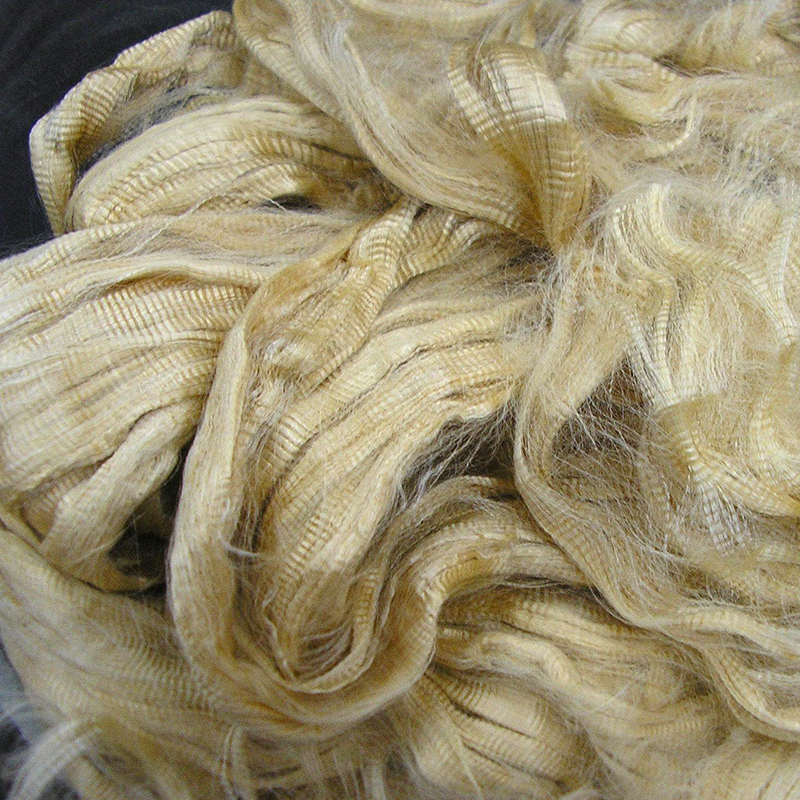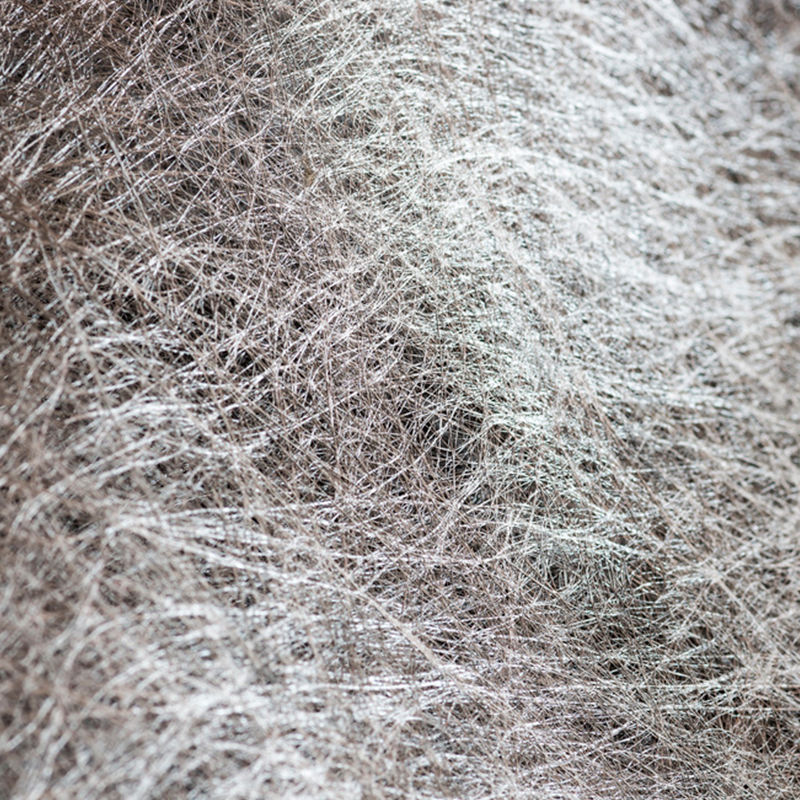
Sense-Tex Fibres
The present invention relates to a composite yarn spun of separate fibers, specifically a soybean fiber, a cellulose fiber with incorporated organic seaweed, and a Ramie fiber. Fabrics made of different fibers have been used in various garments to achieve properties that cannot be obtained with a single type of fiber, nor can a fabric be manufactured with theese 5 fibers in a traditional way. The aim of this yarn-invention is to provide a high-performance yarn with adaptable surface optic and/or haptic aspects. The disclosed composition product is spun in a mechanical process, similar to a yarn but with properties more like a thread. Unlike ordinary yarn, which is comparatively fragile and prone to breakage, the composition product is made up of at least three different fibers, making it substantially more stable.
Yarn with unique properties
This unique yarn-thread combination offers benefits such as a smooth silky feel and ease of recycling through a reversed mechanical process. In various embodiments, the composite yarn can also include a cellulose fiber enriched with incorporated pharmaceutically pure zinc oxide and a silver coated fiber. The zinc oxide embedded in the cellulose fiber provides antibacterial properties, while the silver coated fiber offers conductivity for electric signals and connection to electronic components. The composite yarn can be produced by combining the fibers using a ring spinning process. The optimal blend of the fibers consists of 30% to 40% soybean fiber, 15% to 25% cellulose fiber enriched with zinc oxide, 15% to 25% cellulose fiber with incorporated organic seaweed, 12% to 18% Ramie fiber, and 8% to 12% silver coated fiber, all by weight. The resulting yarn can be used to create a knitted fabric that possesses the unique properties of the composite yarn.
Offers a wide range of possibilities for the textile industry
By utilizing the advantages of each fiber, the fabric is not only soft and comfortable, but also resistant to bacteria, mold, and other microorganism attacks. In conclusion, the disclosed composite yarn offers a wide range of possibilities for the textile industry, providing garments with enhanced properties and improved recycling capabilities. The yarn can be used to create fabrics that are not only aesthetically pleasing but also promote a healthier and more sustainable lifestyle.

SeaCell
SEACELL is a patented, eco-friendly fiber that has limitless applications in textiles. The fibers are suitable for a broad spectrum of uses in sports and leisure textiles – from underwear and loungewear to soft furnishings. This technology allows us to combine SEACELL fibers with any other fiber, making it universally compatible.
The use of SEACELL fibers lends other textile materials that soft, silky feel and provides maximum levels of comfort. Making it a ground-breaking fiber insofar as it meets the demands of a new generation who leads an active and health-conscious lifestyle.
Smartcell
The zinc oxide contained within SMARTCEL fibers is especially good at protecting skin. These properties have a positive effect on people with sensitive skin or those with skin conditions such as eczema or neurodermatitis. Therefore SMARTCEL enhances the quality of life.
Zinc oxide also protects the skin against harmful UVA and UVB rays which can damage our skin cells. Zinc oxide, as well as having positive effects on the skin, has antibacterial and odor-minimizing properties which keep textiles feeling fresher for longer.


SoyBean
In soybean protein fibre, there are many natural substances that controls different kinds of germina like Staphylococcus Aureus; Baciluscolli; and Candida Albicans etc. As the SoyBean protein has elements within itself such as Soybean Isoflavones; Soybean Saphonin; Oligosaccharide etc. The Far-infrared and Negative Oxyanion in Soybean fibre also has the function of Antibacterial.
Soybean UV Test 1 | Soybean UV Test 2 | Soybean Fibre 1 | Soybean Fibre 2 | Sun Blocking Test | The Soybean Protein Fibres | Test Far Infrared | Test Antibacteria | SGS Test Report
Ramie
Ramie is a linen-like fiber which is classified as a cellulose fiber and is made from the stalks of the Chinese nettle plant.
Ramie is an eco friendly fabric and the highly sustainable fiber is an alternative to synthetic fabrics. It is naturally resistant to mold, mildew and bacteria, as well as light damage and rot and insect attacks. It can be healthily grown without any pesticides, herbicides and chemicals.
Ramie is made from the stalks of flowers and plants and is a chic vegan silk alternative and is lighter and airier. It is able to maintain shapes well. Ramie is also a vegetable fiber that is noted for its length and toughness. Ramie is classified as a cellulose fiber, and although Ramie is not a very common fabric, it is considered sustainable fabric. Ramie can be grown without harmful chemicals as it can naturally resist various pests and diseases, making it a typical environmentally green crop.
Ramie is one of the oldest fiber crops and have been used for fabric production for more than 6,000 years. It is a bast fiber and for textile production, the fiber from the inner bark, or phloem, of the vegetative stalks, are used, rather than the woody stem or bark.


Silver
Silver yarns have antistatic and antibacterial properties, as well as their high electrical and thermal conductivity, silver-plated polyamide yarns are available as monofilaments, multifilament’s and twisted yarns that we use in Sense-Tex. Their antistatic, antimicrobial and thermally conductive properties make them very versatile. The conductive threads can be used for any application.
However, when applied in the wrong manner, flakes of the silver coating can end up in our drinking water, and after much research through SEM analyses and lab tests we have secured this from happening in Sense-Tex.
